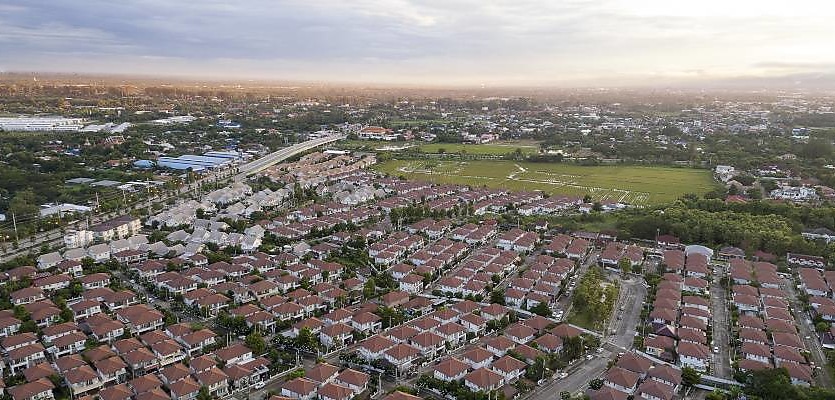New data has shown which of Australia’s capital city suburbs have the highest and the lowest vacancy rates.
New Domain research compiled by senior research analyst Dr Nicola Powell has shown that nationwide, the vacancy rate is still pushing downwards, meaning competition between tenants looking to rent is only getting fiercer.
On a national level, the vacancy rate is now sitting at levels recorded pre-pandemic, at 1.9 per cent.
It’s the lowest vacancy rate seen since March 2020.
While Melbourne and Sydney’s vacancy rates are now trending downwards, they are still higher than in other areas, predominantly due to prolonged lockdowns and higher vacancies noted across inner-city markets.
In Sydney, the vacancy rate is now at 2.8 per cent, slightly lower than the 2.9 per cent vacancy rate recorded in January.
In Melbourne, the rate is a fair bit higher — a result of successive lockdowns — at 4.7 per cent, up by 0.1 of a percentage point from the previous month.
There’s no sign of rental reprieve across some of Australia’s smaller capitals. Hobart has reported a rental vacancy rate of just 0.5 of a percentage point.
The tight situation in Adelaide (0.6 of a percentage point), Perth (0.7 of a percentage point), Canberra (0.8 of a percentage point) and Darwin (0.8 of a percentage point) is not much better.
It begs the question: Which suburbs are struggling with demand, and which suburbs are struggling for supply?
Here’s what Domain has discovered:
Sydney
Highest vacancy rates: Paramatta (4.9 per cent); Strathfield, Burwood, Ashfield (4.5 per cent); Auburn (4.2 per cent); Botany (4.0 per cent); Pennant Hills and Epping (3.9 per cent).
Lowest vacancy rates: Camden (0.4 of a percentage point); Wyong (0.4 of a percentage point); Blue Mountains (0.5 of a percentage point); Gosford (0.5 of a percentage point); Wollondilly (0.8 of a percentage point).
Melbourne
Highest vacancy rates: Melbourne City (11.7 per cent); Stonnington East (8.7 per cent); Stonnington West (8.0 per cent); Whitehorse West (7.5 per cent); Boroondara (6.5 per cent).
Lowest vacancy rates: Mornington Peninsula (0.3 of a percentage point); Nillumbik and Kinglake (0.3 of a percentage point); Yarra Ranges (0.3 of a percentage point); Cardinia (0.4 of a percentage point); Casey North (0.7 of a percentage point).
Brisbane and Gold Coast
Highest vacancy rate: Brisbane – inner (4.3 per cent); Sherwood – Indooroopilly (3.7 per cent); Brisbane – inner west (2.9 per cent); Nathan (2.4 per cent); Mt Gravatt (2.3 per cent).
Lowest vacancy rate: Caboolture Hinterland (0.1 of a percentage point); Capalaba (0.2 of a percentage point); Nerang (0.2 of a percentage point); Mudgeeraba – Tallebudgera (0.3 of a percentage point); Coolangatta (0.3 of a percentage point).
Perth
Highest vacancy rate: Perth City (1.3 per cent); Cottesloe and Claremont (1.0 per cent); South Perth (1.0 per cent); Canning (0.9 per cent); Melville (0.8 of a percentage point).
Lowest vacancy rate: Wanneroo (0.2 of a percentage point); Gosnells (0.3 of a percentage point); Armadale (0.3 of a percentage point); Rockingham (0.4 of a percentage point); Cockburn (0.4 of a percentage point).
Adelaide
Highest vacancy rate: Adelaide City (5.2 per cent); Prospect and Walkerville (1.0 per cent); Holdfast Bay (0.8 of a percentage point); Norwood, Payneham and St Peters (0.6 of a percentage point); Unley (0.5 of a percentage point).
Lowest vacancy rate: Tea Tree Gully (0.1 of a percentage point); Gawler and Two Wells (0.1 of a percentage point); Marion (0.2 of a percentage point); Playford (0.2 of a percentage point), Port Adelaide – East (0.3 of a percentage point).
ABOUT THE AUTHOR

Grace Ormsby
Grace is a journalist across Momentum property and investment brands. Grace joined Momentum Media in 2018, bringing with her a Bachelor of Laws and a Bachelor of Communication (Journalism) from the University of Newcastle. She’s passionate about delivering easy to digest information and content relevant to her key audiences and stakeholders.









You are not authorised to post comments.
Comments will undergo moderation before they get published.